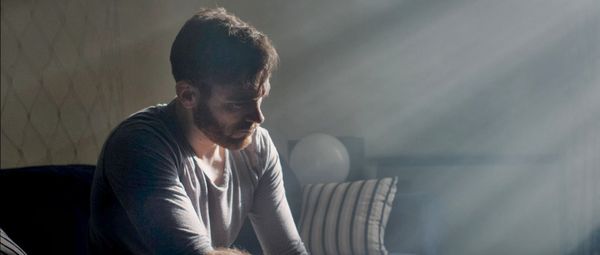Eye For Film >> Movies >> Sarah's Room (2013) Film Review
Sarah's Room
Reviewed by: Jennie Kermode

Sharing a home is something which some people take to easily and others really struggle with. When people with different feelings about this live together, there's serious potential for conflict, especially if one of them really needs that other person for support - and especially if the reason for the need won't acknowledge his problems.
Joe has been away. On his return, he and wife Emma celebrate with their best friends. But Joe has to face the fact that Emma's best friend, Sarah, has now moved in. He's not comfortable about this, he protests. He's a very private person. Perhaps there's a deeper reason. We wonder when we see him peeping into Sarah's room at night. After a while, it becomes apparent that the things Joe thinks he sees and hears might not all be real. Constrained by the requirement for politeness, albeit only so much, he tries with increasing desperation to explain that he's really not coping, but Emma is used to him being difficult and doesn't quite seem to understand the pressure building up.

Grant McPhee's debut feature as a director, the film moves too slowly at first but gradually gathers pace, building to a much stronger conclusion. This is difficult territory for someone with limited experience and sometimes deliberately confused imagery threatens becomes too distancing, so the film's grip slackens. The soundtrack is also a shade too heavy-handed and repetitive, adding to the sense that the film has been padded (one should always be suspicious of 85 minute films as that's the minimum length for many venues). Balancing this, however, is a solid central performance from Patrick O'Brien and attention to detail which contributes to an atmosphere in which sympathy and dread are effectively balanced.
Also worth mentioning is the colour palette, rooted in sepia tones which blend very well with the Edinburgh streets Joe wanders through at night, the pubs where he seeks refuge in alcohol and the claustrophobic domestic environment he finds himself trapped in. Though it's not uncommon for film characters to have no obvious source of income, Joe's inactivity soon suggests that something is amiss. In the room he shares with Emma, the sepia turns into white, too bright, too clinical. Sarah's room blooms in shades of pink and red.
Stories like Joe's are too often told by outsiders. Here, though the film could do with losing some exposition, it's good to see this troubled character foregrounded and presented as a genuinely complex individual. Underneath all the rest is a simple tale of two people struggling to save their relationship in difficult circumstances; but just how much can be forgiven?
Reviewed on: 21 Mar 2014















